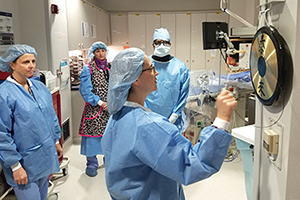By JULIE MINDA
The pre-procedure practice of taking a "time-out" to ensure clinicians verify the patient's name, the procedure about to be performed, patient allergies and other vital information is critical to patient safety, medical experts agree.

Nurse Erica Brenckle strikes a gong to begin a time-out prior to a case in the cardiac catheterization lab at Ascension's St. John Macomb-Oakland Hospital in Warren, Mich.
To help ensure clinicians fully engage in the time-out checklist process and mentally prepare themselves for their role in medical procedures, clinicians in several units at Ascension's St. John Macomb-Oakland Hospital in Warren, Mich., now begin their reviews with the striking of a Tibetan gong.
Erica Brenckle and Delia Gealer, the nurses who came up with and implemented the idea last year, say the use of the gongs has improved the units' compliance with pre-procedure protocols and thus has improved patient safety. Brenckle is lead preceptor for the cardiac catheterization and electrophysiology lab at St. John Macomb; and Gealer is a nurse with the lab.
The Joint Commission has required as part of its accreditation that medical units including cardiac catheterization labs follow the time-out protocol before each procedure they perform. During the checklist clinicians verbalize what they are about to do, stating details about the patient and the procedure, after which staff are to give their verbal assent that all the information is correct — or flag any incorrect information.
A few years ago, a hospital consultant playing the role of Joint Commission inspector during a mock cardiac catheterization procedure dinged the clinical care team for their checklist process. In brainstorming ways to improve the unit's time-out process, Brenckle and Gealer recalled how, when they were students in holistic nurse training sessions at St. John Providence Health System, teachers had used Tibetan chimes to help students center themselves. (Brenckle and Gealer were board certified as holistic nurses through a test by the American Holistic Nurses Association following the hospital's course.)
Brenckle and Gealer reasoned chimes could easily get misplaced in the lab. While paging through a Staples office supply catalog for inspiration on other sound-making instruments, the nurses came across a listing for the Tibetan gong and ordered it. The gong, which is about 14 inches in diameter, is made of metal; and when struck it makes a soothing, medium-pitched sound that lasts about 5 seconds, according to Gealer. The wood and rubber mallet that came with the gong was replaced with a surgical hammer to comply with infection control standards.
Brenckle says for some cultures the striking of a gong symbolizes the beginning of a spiritual event, prayer, meditation or ceremony. The gong's energy and sound wave vibrations clear the mind, enhance focus and connect the energy of the people in the room, according to some spiritual theories, she says.
In the catheterization lab, a team member strikes the gong when all staff participating in a procedure are assembled in the room and ready to run through the patient safety checklist. The patient is in the room during the checklist run through. Most patients are sedated but conscious during the time-out. The gong is struck in such a way as to not alarm the patient.
Brenckle and Gealer say the gong took some getting used to. Some clinical staff initially were skeptical and somewhat resistant to its use. Some staff cracked jokes about "The Gong Show," the TV program where a gong strike signals an abrupt, premature end to a contestant's oddball or pitchy performance. Jokes aside, both nurses say, the gong does its job, focusing attention, and the vast majority of staff now embrace its use. One Japanese physician always strikes the gong at the end of a procedure and bows to his colleagues.
During a follow-up evaluation of the catheterization unit's procedures, the hospital consulting firm commended the staff's use of the gong. After that endorsement, some St. John Macomb operating rooms and its endoscopy unit got their own gongs. A surveyor from the Joint Commission also was impressed with the use of the gong, according to Brenckle.
» Listen to the sound of the gong.
Copyright © 2017 by the Catholic Health Association
of the United States
For reprint permission, contact Betty Crosby or call (314) 253-3490.